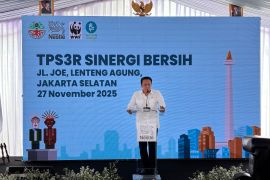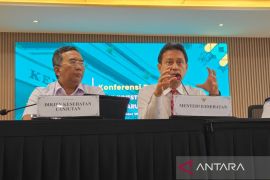The BUMN Ministry set profit target for all state companies at Rp250 trillion in 2018 , up from 2017`s target of Rp197 trillion.Medan, N Sumatra (ANTARA News) - Toward the end of 2017, Minister of State Enterprises Rini Soemarno invited to a meeting chief executives of 115 state-owned companies (BUMN).
At the meeting in Toba Samosir, North Sumatra, the minister and the chief executives evaluated the performance of the BUMNs and discussed plans for 2018.
High on the agenda was how to revitalize some of the BUMNs ending the year 2017 with losses.
There were 14 units of BUMN feared to be in the red by the end of 2017, though the number was smaller than 24 units in the first half of 2017. The causes of the losses were either failure in market competition, or incompetency in management.
Based on data from the BUMN Ministry, the 24 companies being in the red in the first half of 2017 included PT Rajawali Nusantara Indonesia, Bulog, PT Berdikari, PT Indofarma, PT Energy Management Indonesia , PT Hotel Indonesia Natour, PT Pos Indonesia, PFN, PT Aneka Tambang, PT Balai Pustaka, PT PAL Indonesia, PT Dok dan Perkapalan Surabaya, PT Krakatau Steel Tbk, PT Boma Bisma Indra, PT INTI , PT Dirgantara Indonesia, PT Amarta Karya, PT PDI Pulau Batam, Damri, PT Garuda Indonesia Tbk, PT Danareksa , PT Pengembangan Armada Niaga Nasional, PT Iglas , and PT Istaka Karya.
The BUMN Ministry has taken a number of strategic steps but it is feared that a number of BUMNs were still in the red such as PT Garuda Indonesia, PT Krakatau Steel, PT Kertas Leces, PT Dirgantara Indonesia and PT Merpati Nusantara Airlines aggregating a loss of around Rp4 trillion. The total loss was smaller than Rp5 trillion in 2016 and Rp13 trillion in 2013.
The largest losses were recorded by the nation`s flag carrier Garuda Indonesia, and the country`s largest steel maker Krakatau Steel each reporting a loss of more than Rp1 trillion, according to the estimate.
Garuda suffered losses as it became victim of tariff war with airlines undercutting each other in ticket price in the domestic market. Its losses were also attributable to inefficient operation of international routes.
Losses suffered by Krakatau Steel were attributable mainly to failure in market competition worsened by Chinese dumping in steel market.
BUMNs, therefore, are expected to improve efficiency and creating synergy between them to prevent more losses. Those operating in the same lines of business are grouped under holding companies.
Finance Minister Sri Mulyani Indrawati said the government will continues to improve professionalism in the management of BUMNs.
"The professionalism of BUMN management has to be strengthened that BUMNs could be relied on to carry on with their respective business assignments," Sri Mulyani said.
Holding companies
The grouping of state companies under holding companies has been planned even before the present government, but concrete steps began only in 2017.
The program has been prompted mainly by the need to create world class companies in facing competition under the ASEAN Free Trade Agreement (AFTA).
Toward the end of 2017 a holding company was established for state companies operating in the mining sector . Wholly owned aluminum smelter operator Inalum in North Sumatra became the parent company for general mining company PT Antam Tbk, coal mining company PT Bukit Asam Tbk, and tin mining company PT Timah Tbk.
With the grouping, Inalum is expected to be able to compete globally against other big companies operating in the same line of business.
"The holding company in the mining sector is to increase business capacity in managing coal and mineral resources, to increase added value through development of processing industry and improvement of cost efficiency through synergy," Chief Executive of Inalum Budi Gunadi Sadikin.
The holding company is also to expand business through acquisition and explorations and in long term it hopes to break into the ranks of 500 Fortune Global Company, Budi said.
Earlier the government already form holding companies for those operating in cement industry, fertilizer industry and plantation sector.
The government through the BUMN Ministry would continue with the program of putting other state companies under holding companies despite doubt expressed by some observers and criticism including from among the lawmakers. Five more holding companies are planned including for state companies operating in energy sector, banking and financial service industry, construction and toll road sector, housing sector and food sector.
More in the center of public attention is the plan to hold holding company in the energy sector. Oil and gas company PT Pertamina is to be the parent company putting gas distributor PT Perusahaan Gas Negara (PGN), as one of the subsidiaries. The process of forming the holding company is to be wrapped up in first quarter of 2018.
Deputy for Business Restructuring and Expansion at the office of the BUMN Ministry Aloysius Kiik Ro said there should be no problem in the establishment of the holding companies as Pertamina, Pertagas and PGN are already committed to supporting the program.
The holding company for state lenders and other financial companies is also expected to be formed in the first quarter of 2018.
The BUMN Ministry also will launch restructuring program to streamline the number of subsidiaries of other state companies such as those operating in logistic sector.
Airport operators PT Angkasa Pura I and PT Angkasa Pura II, Board of Logistic (Bulog), railway company PT Kereta Api Indonesia (KAI), all have subsidiaries operating in logistic sector.
"This is not efficient . We will combine them through merger and each of them will have a stake in the combined company," Rini said.
Similarly, state companies operating hospitals would be merged under one management to be larger in business capacity under a single management.
Infrastructure
In the first three years of the government of President Joko Widodo infrastructure development has been brisk. Infrastructure development is put high in priority to strengthen the competitive edge of the country`s economy.
BUMNs, therefore, as agent of development and a driving motor for economic growth play a big role in the infrastructure development, which is estimated to cost Rp5,500 trillion until 2019. The fund is to finance construction of new power generating plants, 1,000 kilometers of new toll roads, building new or expanding airports and seaports and other infrastructure projects.
The BUMN Ministry has moved fast to carry out the program with target set by the government.
"BUMNs are to concentrate on increasing investment in infrastructure projects mainly to create land, sea and air connectivity," Rini said.
The economy would grow faster with sufficient infrastructure not only road, airport, seaport infrastructure but also electricity and other infrastructure, she said.
Hundreds of infrastructure projects being built to redress economic imbalance or gap between Java and non Java. Many big projects have been built or under construction such as toll road, railways, port and and airport such as in Sumatra and Kalimantan, Sulawesi and Papua.
Finance Minister Sri Mulyani said development of infrastructure is the government`s strategy to modernize and facilitate development of the country`s economy.
The Finance Ministry guarantees capital for BUMNs carrying out infrastructure projects that implementation would not be hampered on financial difficulty.
With strong capital BUMNs would be in a better position to win the confidence of international financing agencies in seeking low interest loans to finance infrastructure projects, Sri Mulyani said.
"We want to ensure that BUMNs are managed with healthy financial balance. We promise to provide guarantee for direct loan from international financial agencies for BUMNs to strengthen their leverage," she said.
The BUMN Ministry set profit target for all state companies at Rp250 trillion in 2018 , up from 2017`s target of Rp197 trillion.
Secretary General of the BUMN Ministry Imam Apriyanto Putro said there are a number of targets to be achieved by the ministry such as assets of Rp7,500 trillion of all BUMNs , capital spending Rp550 trillion-Rp700 trillion and BUMNs contributions of Rp43 trillion to state revenues and taxes at 200 trillion-Rp275 trillion.
(T.SYS/B/H-ASG/F001)
Reporter: Royke Sinaga/A. Saragih
Editor: Heru Purwanto
Copyright © ANTARA 2018












